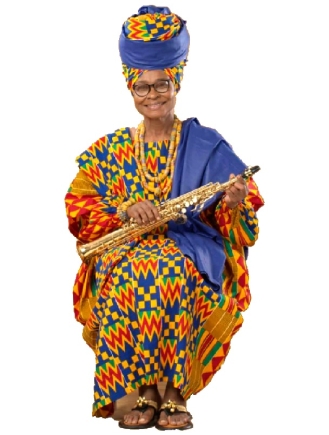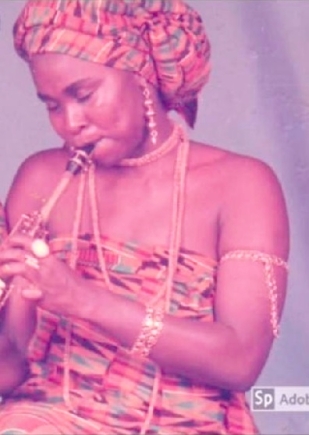As a little girl growing up with her fashion-conscious mother and grandmother, she was always enthralled with how the two older women bound scarves close to their heads and secured them at the front, back or side of the head in a neat knot.
She pressured them to teach her how to tie, roll up and tightly tuck in different styles of headwear and now musician Queen Asabia Cropper stands out everywhere she goes with her enduring and unmistakable kente headwraps.
She first wore a kente headwrap on stage as a member of the Sweet Talks Band in 1975, and she gladly recalled 50 years of doing that when she appeared on the bill at the Highlife Heritage Concert 2025 on November 13, 2025, at the Backpass Restaurant in Accra.
At the concert, Queen Asabia brought on a few young women to model some of her now iconic kente headwear. She felt proud that she had managed to hold on to what has become a distinctive aspect of her public image.
“There’s nothing like doing something you love very much and seeing it bloom. African women are known for covering their heads in one way or the other on almost all occasions,” Queen Asabia says. I decided I wanted to do it with the kente fabric. I think the effort has enriched and inspired us in projecting a culturally-positive identity of ourselves.”

The woman is widely known as the Queen of Highlife. She joined the Black Hustlers Band after her time with the Sweet Talks. She and her bassist brother, Nene Agyeman, later struck out on their own and have travelled the world performing Highlife. Her best-known songs include ‘Womaya’, ‘Towia’ and ‘Love You So Much’.
According to Queen Asabia, she didn’t start out wearing those big headwears she’s come to be identified with. She began by just tying kente in her own different ways around her head.
With time, she added the ‘little magic touch’ of using layers of kente fabric to create a variety of styles that often towered upwards.
“I have a whole catalogue of names for those styles. I often name them after mountains. So they include Kloyo (Krobo mountains), Afajato, Kwahu Mountains and Kilimanjaro, which is in honour of my treasured role model, Miriam Makeba of South Africa.”
To Queen Asabia, if our women are impressed with and don’t mind wearing imported wigs and hairpieces of all sorts from elsewhere, then they should be proud to wear headgears that reflect ourselves.

She often refers to the period when she lived and worked in La Côte d’Ivoire, where she made admirable fashion statements with kente.
According to her, the Ivorians loved her image of constantly wearing kente with beads. She disclosed that they started calling the Krobo type of beads she wore as ‘Asabia’ and kente as ‘Pagne du Asabia’ or ‘Asabia’s cloth’.
Writing about Asabia in the March/April 1993 edition of Awo magazine, Audrey Gadzekpo stated: “She asserts herself in both her art and her style of dress. Long before kente was fashionable, she became Ghana’s de facto ambassador by dressing in kente from head to toe — literally.
Her trademark headwrap, kente dress and kente shoes are her trademark way of telling the world that she is proud to be Ghanaian, proud to be African.”
To Asabia, it doesn’t matter if the headwear is big, short, long or wide. Once it is artistically arranged and worn with real pride, it should make us glow inside and thank God for who we are.
She’s happy that many women from Ghana and the African diaspora have held on to kente headwear as a symbol of pride. To her, the colours in kente signify togetherness, and that’s why she calls one of her headwraps ‘Everybody Dey Inside’.
“I have travelled widely. There have been times when people I met in other countries asked to be taught how to wear the kente headwrap. I have always been happy to oblige because it’s all a way of telling people about Ghana. We import so many things, so exporting something about our sense of dress and culture is also worth it.”
It doesn’t bother her that some people say they originated the big kente headwraps. Her wish is simply to see more people around the world accept and identify with kente and wear the fabric in ways they choose to emphasise their Ghanaian or African pride.
“We have to praise God for everything. We are eternally grateful for kente and should continue to push for its wider usage around the globe.
We have done and continue to do our little bit towards making the fabric identifiable everywhere. We hope those who come after us will take up the mantle and run with it,” Queen Asabia stated.

